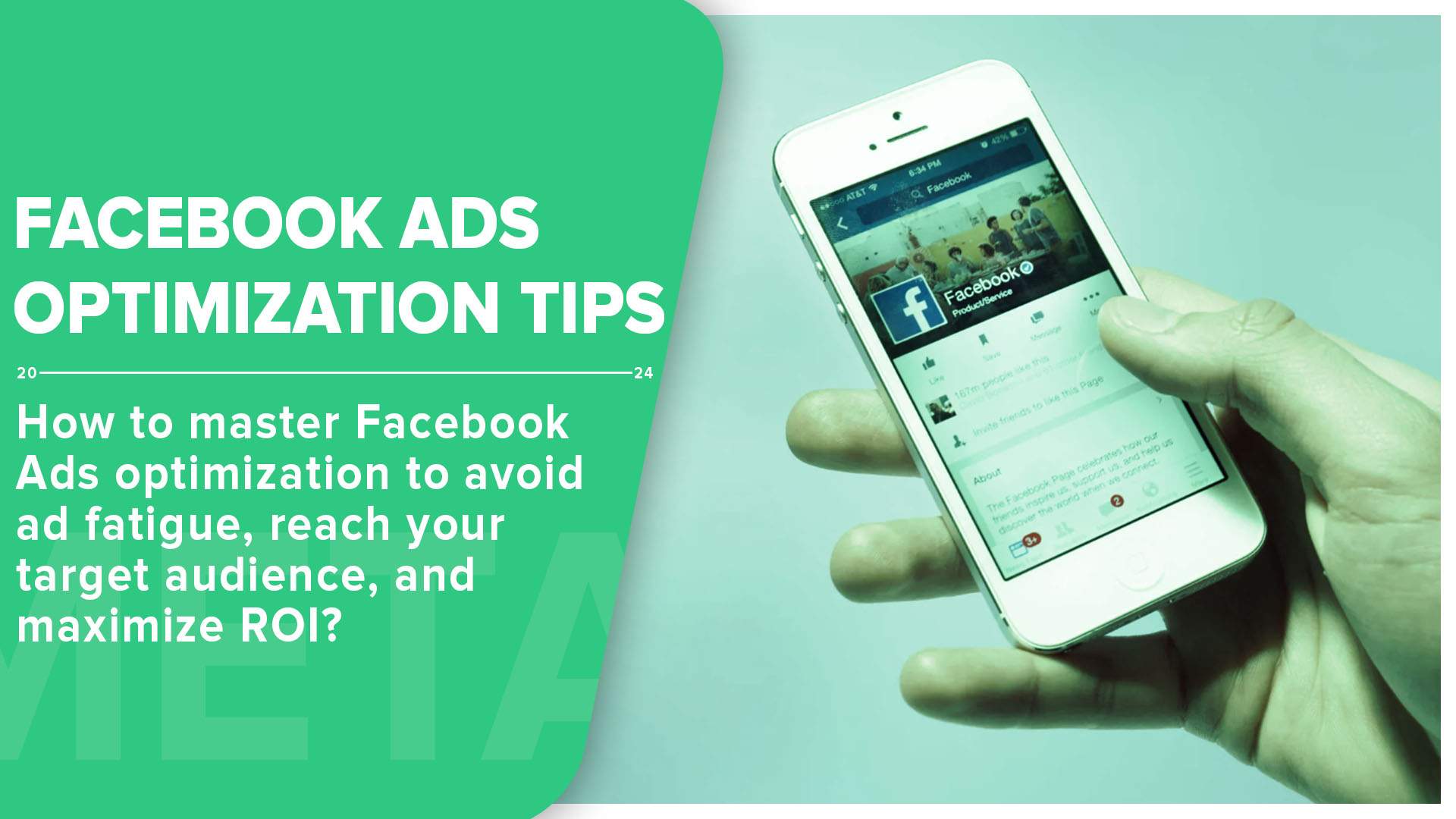
With over 3 billion monthly active users, Facebook is a goldmine of opportunities for marketers and brand managers. It’s where prospective buyers hang out, looking for everything from the latest trends to solutions for everyday problems. For businesses, this means a massive customer base to promote their products, driving quality traffic and leads.
Facebook ads bridge this gap between customers and businesses. Targeting users based on their demographics, interests, and behaviors, these paid posts ensure that your ads are shown to the right people at the right time. This drops the customer acquisition costs for brands, leading to a happy bottom line and even happier customers.
But with great power comes great responsibility. If Facebook ads are effective for converting highly qualified leads, it’s safe to say the competition is testing them out. Let’s look at seven time-tested Facebook ads optimization tips to help you stand out among them.
Facebook Ads Basics
Facebook Ads: Definition + Benefits [For Small Businesses]
Facebook Ads are paid messages that appear on the platform’s property, from news feeds to stories and within Messenger. These ads are personalized for different audience groups based on demographics, age, location, interests, and behaviors. For example, a local bakery can target users within a 10-mile radius with an interest in cooking or baking.
Or a gaming brand may narrow its targeted age bracket to 18-35. Likewise, an online travel agency can target those who have recently searched for “flights” or “hotel stays” on Facebook. Facebook ads minimize wasteful spending on uninterested customers by zooming in on the exact audience you want to reach.
They also help businesses earn the best return on their investment, thereby maximizing the ad impact and reach. While this figure may vary depending on the industry and ad quality, Facebook ads have an average return on ad spend (ROAS) of around 4x. This means for every dollar you invest in Facebook ads, you can earn around 4 dollars back.
Here are the benefits of Facebook ads for small businesses:
- Cost-Effective Advertising: Facebook ads are affordable, with an average cost-per-click of $1.72. This means you can start with as little as you want.
- Detailed Analytics: With Facebook ads, you get a precise analytical report of how well your marketing efforts are performing, facilitating data-driven decisions.
- Retargeting Features: Businesses can retarget ads to users who have previously interacted with their brand, like those who have added items to their cart.
Why Is Facebook Ad Optimization Important?
Running ads on Facebook is one thing; ensuring they provide a good return on investment (ROI) is another. Ad optimization is the practice of fine-tuning your ad campaigns to improve their performance and get closer to your marketing goals.
It involves looking at different aspects of your ads and adjusting them to improve their reach, engagement, and conversion rates. The goal is to get the best return on your advertising dollars. This is done by making sure your ads reach the right people at the right time — and with the most engaging content.
1. Avoid Ad Fatigue
When your target audience sees your ads too many times, it starts to grow tired of them, developing ad fatigue. At this point, people stop paying attention to your campaigns in their news feeds because they’re now immune to them. No one clicks on your ads, which skyrockets your campaign’s costs. This is where ad optimization helps. It prevents ad fatigue (a marketer’s worst nightmare) by monitoring frequency and rotating ads to keep them fresh.
2. Reduce Advertising Costs
Optimization ensures that your ad budget is used most efficiently by regularly adjusting campaigns based on their performance. This means you can reduce the budget on ad groups that are not performing well, cutting down on wasteful spending. To do this, all you need to do is monitor ad metrics like cost per click (CPC) and cost per acquisition (CPA). Then, ensure your money is being spent where it matters the most; if not, adjust the strategy.
3. Improve Ad Relevance
The relevance score is a metric used by Facebook to measure how well an ad is received by its target audience. It is based on positive and negative feedback an ad gets, including app installs, clicks, and when someone hides (or reports) the ad. The higher the relevant score is, the lower its costs are (with better ad placements).
Optimization helps improve this score by adjusting different components of a campaign — such as the creative, copy, and targeting — to better align with its audience.
7 Meta Ads Optimization Tips
1. Define Your Goals
For most e-commerce businesses, the ad objective is to drive sales and revenue through digital web pages. However, that doesn’t mean you should have the same goals in mind. In fact, Facebook ads work best as part of a full-funnel strategy, nurturing customers through the sales cycle. Think about it: if a new jewelry store chooses the “Conversions” objective, would it get a high return on its advertising spend?
Probably not. Because if customers don’t go through the “Awareness” stage first, they likely won’t have enough trust in the brand to make a purchase right away. According to the marketing rule of 7, customers need to be exposed to a brand’s message seven times before they even remember it. In other words, your targeted audience needs to know who you are and what you offer before being pushed for a purchase.
So, before launching an ad, think about your goals and objectives — or what you want to achieve from this campaign. Consider things like:
- Do I want to increase brand awareness or generate leads?
- Is my target audience just starting to know my brand or ready to buy?
- Do I need to grow my email subscriber list or increase app installs?
- Is my campaign focused on achieving long-term goals or immediate sales?
- Am I focusing on retaining existing customers or re-engaging inactive ones?
2. Craft Compelling Ad Copy
First impressions matter, even in Facebook ads. That’s why you have to ensure that the content of your ad copy resonates well with the target audience. You have to tell your story in a way that hits their pain points and compels them to take action. This may include signing up for a newsletter, visiting the web page, or, better, making a purchase. You might as well use the most popular copywriting techniques that will help you craft a compelling story that resonates with your audience and addresses their pain points early on.
Before writing it, know who your target audience is — what are their interests, pain points, and needs? Then, grab attention with a strong headline that clearly tells what your ad is about. As per Copyblogger, around 80% of people will read your headline, but only 20% will read the rest of the ad. It’s all about hooking the audience from the get-go.
Follow these steps to write copy that converts:
- Use power words within the headline, like “free” and “limited time.”
- Pair features with their benefit for the user (save time with x, get fit with y)
- Personalize your CTA, as it performs 202% better than basic CTAs (“transform your home” instead of “learn more”).
- Include quotes from satisfied customers as social proof to build credibility.
- Throw data-backed insights to support your claims (Join over 10K satisfied users).
- Be honest, genuine, and authentic – and express your personality.
3. Use a Full-Funnel Approach
If you’re investing in a top-of-the-funnel campaign, you’re losing your advertising dollars and pumping the customer acquisition costs. In other words, you’re doing yourself more harm than good. A successful ad strategy is based on nurturing your leads through the funnel. You have to make them aware of your brand, get them interested, and gradually convert them.
There are three stages in the full-funnel approach: Awareness, Consideration, and Conversion. Let’s look at all of these in detail.
|
Campaign Objective |
||
|
Awareness |
Consideration |
Conversion |
|
● Brand awareness ● Reach |
● App Installs ● Engagement ● Traffic ● Lead Generation ● Messages ● Video Views |
● Catalogue Sales ● Store Traffic ● Conversions |
Awareness
This is the top of the funnel where you introduce your brand to a broad audience. The goal is to tell people who your business is and what it does. In this stage, you create attention-grabbing video ads, images, and stories that highlight your brand’s unique value proposition. Sprinkle a storytelling aspect, too, as it improves your brand value by 20%.
Consideration
In this middle stage, you nurture prospects who have shown interest. The aim is to build their interest in your offering further and make them “consider” it. For example, you can retarget users who watched 50% or more of your video ads with carousel ads (that show detailed descriptions of your best-selling products).
You can also benefit from having a blog page at this stage by publishing product demos, comparison guides, and testimonials. After all, companies that blog get 55% more website visitors, as Hubspot suggests.
Conversion
As the dream objective of all marketers and brand owners, conversion lies at the bottom of the funnel. It is where you encourage nurtured leads to take a specific action, like signing up for a newsletter or making a purchase. In the conversion stage, you narrow down the audience targeting to those who have shown strong intent (like adding items to the cart). To convert audiences, use strategies like discounts or free trials to drive immediate action.
4. Keep Ad Frequency in Check
Having too much of a good thing can backfire, and this applies to your ads as well. When people repeatedly see your ads without responding, it’s a clear sign they’re not interested. Besides wasting your advertising dollars, this also annoys potential customers and damages your brand image — a phenomenon known as ad fatigue.
It occurs when users see the same ad too often, which causes them to grow tired and indifferent, thereby hiking your campaign costs. Thus, use the Facebook Ads Manager to monitor your ad frequency and aim to keep this number below three. Likewise, keep an eye on engagement rates because a drop in likes and comments is a clear sign of ad fatigue.
5. A/B Test Your Ad Campaigns
A/B testing, also known as split testing, is a method where you compare two versions of an ad to see which one performs better. The winning strategies can be applied to future campaigns to improve ROI, leading to higher conversion rates and less wasteful spending. To do this, select one variable to test at a time to isolate its impact. These may include:
- CTA buttons
- Text length
- Headlines
- Ad copy
- Ad formats (Image or video)
- Target audience
Then, draft two versions of the ad within Facebook’s own platform, the only difference being the variable you’re testing. Wait for at least 24 hours before checking the algorithm report by Facebook — and see which version is perceived well by the audience. Analyze key metrics like CTR, conversion rate, and cost per conversion to find (and implement) the winner.
Note: Run both versions of your ad at the same time. This helps control external factors like time of day or day of the week, which may impact performance. Also, use a sample size of at least 1,000 impressions per version.
6. Test Out Lookalike Audiences
Have you already converted all the high-potential clients in your target group and are now seeing the advertising costs rise? It’s time to test out lookalike audiences. This targeting option on Facebook lets you reach new people who are just like your existing customers. To do this, the platform analyzes the traits of your best-performing audience segments, such as demographics, interests, and behavior.
Then, it finds new users who share the same characteristics, thereby generating new leads while keeping the acquisition costs low. To test out lookalike audiences, choose your base audience with at least 100 users — more is better. Then, define the audience size between 1% and 10% (with 1% reflecting the highest similarity) and start experimenting.
7. Use the Fast Takeoff Method
While it doesn’t fall directly in Facebook optimization tips, using the fast takeoff method to obtain actionable insights before the ad spend gets too high. In this method, you initially launch your campaigns with a higher budget to accelerate the learning phase.
Once the algorithmic data comes in, you make informed decisions and refine your campaigns for better performance. But why use this method? Well, sometimes you have a small campaign budget, which means the impressions won’t be much. This means it will take longer to generate ad insights and get through the learning phase. Fast takeoff helps here, bringing data in quicker so you can cash on higher engagement and conversion rates.
Conclusion
It isn’t easy to be accustomed to all Meta ads optimization tips when you get started. But with time and experimentation, you can certainly get the hang of your Facebook ads marketing game. All you need to do is have clear objectives from the start and know where your target audience is.
Then, keep these metrics in mind when drafting ad copies to resonate with the pain points of potential customers, thereby nudging them toward a purchase. The bottom line is to regularly monitor your campaigns, make data-driven decisions, and not be afraid to test new strategies.
Which Facebook Ads optimization tip will you try next?




